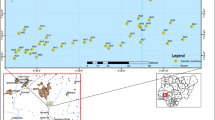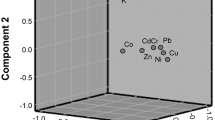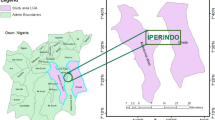Abstract
Mining of tin and other related activities have been active and thus leading to economic growth in the Jos area of Nigeria for more than a century. However, mining of minerals has been confirmed to enhance the concentrations of heavy metals and natural radioisotopes in the soil, air and water bodies in the environment. In an attempt to evaluate the radiological burdens resulting from tin mining activities at Rayfield-Du area of Jos, specific activities of naturally occurring radioactive nuclei (238U, 232Th and 40K) concentrations were evaluated in soil samples collected from the mine site. The soil samples were classified as normal soil (S), tailings (T) and mineral soils (M) and their corresponding mean activities for 238U, 232Th and 40K were analysed using an HpGe detector-based gamma spectrometric system. The mean activity concentration for 238U, 232Th and 40K were 323.44, 877.63 and 864.99 Bq/kg, 138.84, 469.31 and 578.65 Bq/kg and 168.83, 436.08 and 346.1 Bq/kg, respectively for M, T and S samples. The calculated radiation dose parameters for the soil samples were all higher than the recommended safety limit. For all the collected soil samples, the external hazard risk Hext were 2.21, 2.81 and 4.44 for S, T and M, respectively while the mean calculated radium equivalent was 819, 1057 and 1645 Bq/kg for S, T, and M, respectively. The excess lifetime cancer risk estimated for the mine was more than the world average value. The radio-ecological dose rate estimate for non-human biota in the mine revealed that all non-human species except lichen and bryophyte had absorbed dose rate less than the 10 µGy/h screening dose.









Similar content being viewed by others
References
Abba HT, Hassan WM, Saleh MA (2018) Evaluation of environmental natural radioactivity levels in soils and ground water of Baarkin Ladi, Plateau state Nigeria. Malays J Fundam Appl Sci 14(3):338–342
Adegboye MA (2012) Effect of mining on farming in Jos South Local Government Area of Plateau state. J Soil Sci Environ Manag 3(4):77–83
Ademola JA (2008) Exposure to high background radiation level in the tin mining area of Jos, Plateau, Nigeria. J Radiat Prot 28:93–99
Ajayi IR (2008) An evaluation of the equivalent dose due to natural radioactivity in the soil around he consolidated tin mine in Baukuru-Jos, plateau state of Nigeria. Iran J Radiat Res 5:203–206
Aliyu AS, Ramli AT (2015) The world’s high background natural radiation areas (HBNRAs) revisited: a broad overview of the dosimetric, epidemiological and radiobiological issues. Radiat Meas 73:51–59
Aliyu AS, Mousseau TA, Ramli AT, Bununu AY (2015) Radioecological impacts of tin mining. Ambio 44:778–787
Amaral ECS, Rochedo ERR, Paretzke HG, Franca EP (1992) The radiological impact of agricultural activities in an area of high natural radioactivity. Radiat Prot Dosim 45:289–292
Arogunjo AM, Hollriegl V, Giussani A, Leopeld K, Gerstmann U, Veronese I, Oeh U (2009) Uranium and thorium in soils, minerals sands water and food samples in a tin mining area in Nigeria with elevated activity. J Environ Radioact 100:232–240
Beresford NA, Gaschak S, Barnett CL, Howard BJ, Chizhevsky I, Strømman G, Oughton DH, Wright SM et al (2008) Estimating the exposure of small mammals at three sites within the Chernobyl exclusion zone—a test application of the ERICA tool. J Environ Radioact 99:1496–1502
Beretka J, Mathew PJ (1985) Natural radioactivity of Australian building materials, industrial wastes and by-products. Health Phys 48:87–95
Deng W, Tian K, Zhang Y, Chen D (1997) Radioactivity in zircon and building tiles. Health Phys 73:369–372
De-Wet PD (1996) The occurrence and bio-accumulating of selected metals and radionuclides in aquatic and terrestrial ecosystem on the water sand. Unpublished Ph.D. thesis, Africans University, Johannesburg
Forster L, Forster P, Lutz-Bonengel S, Willkomm H, Brinkmann B (2002) Natural radioactivity and human mitochondrial DNA mutations. Proc Natl Acad Sci 99:13950–13954
Haridasan PP, Paul AC, Desai MVM (2001) Natural radionuclides in the aquatic environment of a phosphogypsum disposal area. J Environ Radioact 53:155–165
Hartley BM (2001) The measurement of radiation levels in Australian zircon milling plants. Health Phys 80:16–23
Hofman J, Leicht R, Wingender HJ, Worner J (2000). Natural radionuclide concentrations in materials processed in the chemical industry and the related radiological impact. Report EUR 19264
IAEA International Atomic Energy Agency (1992) Effects of ionizing radiation on plants and animals at levels implied by current radiation protection standards. Technical reports series no. 332. Vienna
IAEA (2011) Basic Safety Standard. International Atomic Energy Agency, Vienna
Ibeanu I (2003) Tin mining and processing in Nigeria: cause for concern. J Environ Radioact 64(2003):59–66
ICRP (2008) Environmental protection - the concept and use of reference animals and plants. ICRP Publication 108. Ann ICRP 38(4–6)
Jibiri NN, Farai IP, Alausa SK (2007) Estimation of annual effective dose due to natural radioactive elements in ingestion of foodstuffs in tin mining area of Jos-Plateau, Nigeria. J Environ Radioact 94:31–40
Jibiri NN, Alausa SK, Farai IP (2009) Assessment of external and internal doses due to farming in high background radiation areas in old tin mining localities in Jos-Plateau, Nigeria. Radioprotection 44(2):139–151
Jibiri NN, Alausa SK, Owofolaju AE, Adeniran AA (2011) Terrestrial gamma dose rate and physic-chemical properties of form soil from ex-tin mining locations in Jos-Plateau, Nigeria. Afr J Environ Sci Technol 5:12
Jwanbot DI, Izam MM, Gambo M (2012) Measurement of indoor background ionizing radiation in some science laboratories in University of Jos, Jos—Nigeria. Sci World J 7(2):5–8
Lind OC, Stegnar P, Tolongutov B, Rosseland BO, Strømman G, Uralbekov B, Usubalieva A, Solomatina A, Gwynn JP, Lespukh E, Salbu B (2013) Environmental impact assessment of radionuclide and metal contamination at the former U site at 586 Kadji Sai, Kyrgyzstan. J Environ Radioact 123:37–49
Macleod WN, Turner DC, Wright EP (1971) Geological survey of Nigeria: the geology of the Jos Plateau: explanation of 1:100,000 sheets nos. 147, 148, 168, 169, and 189 and 190. Lagos
Marsden E (1960) Radioactivity of soils, plants and bones. Nature 187:192–195
Masok FB, Ike-Ogbonna MI, Dawam RB, Jwanbet DI, Yenle NM (2015a) Cancer risk due to radionuclide concentration in tin Ore and sediments at Barkin-Ladi, Plateau State, North Central, Nigeria. Int J Environ Monit Anal 3(5):260–264
Masok FB, Paulus LM, Jwanbot ID (2015b) Natural radioactivity concentration and effective dose rate from Jos tin mining dumpsites in Rayfield, Nigeria. J Environ Earth Sci 5(12):51–56
Møller AP, Mousseau TA (2011) Efficiency of bio-indicators for low-level radiation under field conditions. Ecol Indic 11:424–430
Møller AP, Mousseau TA (2013) The effects of natural variation in background radioactivity on humans, animals and other organisms. Biol Rev 88:226–254
Møller AP, Nishiumi I, Suzuki H, Ueda K, Mousseau TA (2013) Differences in effects of radiation on abundance of animals in Fukushima and Chernobyl. Ecol Indic 24:75–81
Musa HD, Jiya SN (2011) An assessment of mining activities impact on vegetation in Bukuru Jos Plateau State Nigeria using normalised differential vegetation index (NDVI). J Sustain Dev 4(5):150–159
NPC-National Population Commission (2006) Nigeria national census: population distribution by sex, state, LGAs and senatorial district. Priority tables vol. 3. https://www.population.gov.ng/index.php/publication. Accessed 23 Jan 2020
Odoh R, Ogah E, Oko OJ, Yebpella GG, Magomya AM (2018) Assessment of some physico-chemical parameters of drinking water sources, in Okpokwu and Ogbadibo areas of Benue state. Sci-Afr J Sci Iss Res Essays 5:1–5
Olarinoye IO, Sharifat I, Baba-Kutigi AN, Kolo MT, Aladeniyi K (2010) Measurement of background gamma radiation levels at two tertiary institutions in Minna, Nigeria. J Appl Sci Environ Manag 14(1):59–62
Olise FS, Oladejo OF, Almeida SM, Owoade OK, Olaniyi HB, Freitas MC (2014) Instrument neutron activation analyses of uranium and thorium in samples from tin mining and processing sites. J Geochem Explur 142:36–42
Ramli AT, Aliyu AS, Agba EH, Saleh MA (2014) Effective dose from natural background radiation in Keffi and Akwanga towns, central Nigeria. Int J Radiat Res 12:47–52
UNSCEAR (1996) Sources and effects of ionizing radiation. Report to the general assembly with scientific annex A/AC.82/R.54. United Nations, Vienna
UNSCEAR (2008) Effects of ionizing radiation on non-human biota. United Nations Scientific Committee on the Effects of Atomic Radiation, New York
UNSCEAR (2000) Sources and effects of ionizing radiation, United Nations scientific committee on the effect of atomic radiation report vol. 1 to the general assembly, with scientific annexes. United Nations Sales Publication, United Nations, New York
USDoE (2002) A graded approach for evaluating radiation doses to aquatic and terrestrial biota. Technical standard DoE-STD-1153-2002. Washington DC, USA
Usikalu MR, Anoka OC, Balogun FA (2011) Radioactivity measurements of the Jos tin mine tailing in Northern Nigeria. Arch Phys Res 2(2):80–86
Wapwera SD, Ayanbimpe GN, Odita CE (2015) Abandoned mine, potential home for the people: a case study of Jos Plateau tin—mining region. J Civ Eng Archit 9:429–445
Xinwei L, Lingqing W, Xiaodan J, Leipeng Y, Gelian D (2006) Specific activity and hazards of Archeozoic–Cambrian rock samples collected from the Weibei area of Shaanxi, China. Radiat Prot Dosim 118:352–359
Author information
Authors and Affiliations
Corresponding author
Additional information
Publisher's Note
Springer Nature remains neutral with regard to jurisdictional claims in published maps and institutional affiliations.
Rights and permissions
About this article
Cite this article
Atipo, M., Olarinoye, O. & Awojoyogbe, B. Comparative analysis of NORM concentration in mineral soils and tailings from a tin-mine in Nigeria. Environ Earth Sci 79, 394 (2020). https://doi.org/10.1007/s12665-020-09136-7
Received:
Accepted:
Published:
DOI: https://doi.org/10.1007/s12665-020-09136-7




